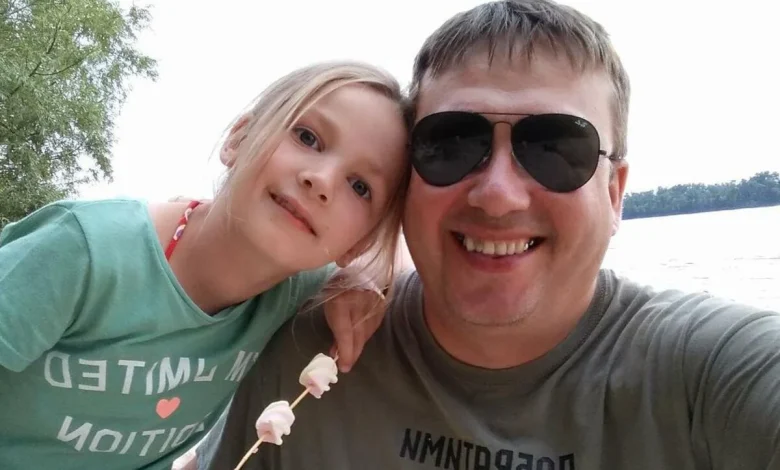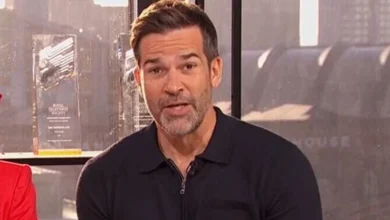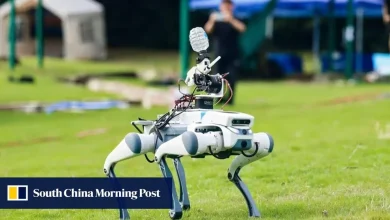Solomiya’s story from Ukraine: How children understand war

Kristina Kljajic
BBC journalist
“And when will the war end and when will you return home?”
This question begins one of the first letters that five-year-old girl Solomiya sent to her father, while he was at the front in Ukraine in 2014.
That year Russia annexed the Crimean peninsula, and in the Donetsk and Donbas regions of eastern Ukraine, Ukrainian forces and pro-Russian rebels clashed.
Thus began their correspondence that would last for several years.
“I looked for markers around the room and tried to draw for him everything I couldn’t explain to him in words.”
“I missed him, I wanted him to know I was thinking of him,” 15-year-old Solomiya Stepanenko tells BBC Serbian today.
In addition to handwritten messages, she also sent her father voice messages, as well as Viber messages, which were often accompanied by a drawing.
This is exactly what made her father feel the need to explain to his daughter as clearly as possible “where he is and what his life looks like now.”
“I realized that it was easier for her when she knew exactly where I was and that gave her a kind of security,” Eugen Stepanenko tells BBC Serbian.
Conversations and correspondence helped her “miss her father less.”
The Stepanenko family moved from Ukraine to Croatia, a country in the Balkans, in 2021.
Russia invaded Ukraine the following year, and the war is still ongoing.
More than 2.520 children have been killed or injured since February 2022, many of them as a result of the widespread use of explosive weapons in populated areas, the data shows. United Nations Human Rights Office.
Universal Children’s Day is celebrated every November 20th.
How do children live in Ukraine?
One in five children in Ukraine lost a relative or friend during the first three years of the war, United Nations data as of February 2025.
Around 1.600 educational institutions and nearly 790 health facilities were damaged or destroyed. in the past three years.
Children in areas of Ukraine occupied by the Russian Federation are particularly vulnerable.
The UN Commission of Inquiry on Ukraine has said there is evidence of the illegal transfer of hundreds of Ukrainian children to Russia.
Russia is implementing policies such as granting Russian citizenship and placing children in foster families to “create a framework in which some children could permanently remain” in Russia, says the UN report.
Around 3,7 million people remain internally displaced, and 6,86 million live outside the country.
While the transfer is intended to be temporary, “most were turned into long-term ones”, with both parents and children facing “a series of obstacles to establishing contact”.
Since the annexation of four regions of Ukraine in late 2022, in violation of international law, the authorities of the Russian Federation have made comprehensive and profound changes to the laws, institutions, and governance there, directly affecting children and their human rights, UN investigators have found.
They imposed Russian citizenship and a Russian school curriculum, while at the same time restricting any access to education in the Ukrainian language.
They prioritized military-patriotic training in school and youth groups, exposing children to war propaganda.
Russian President Vladimir Putin is charged with being responsible for war crimes, including the illegal deportation of children from Ukraine to Russia.
How the letters turned into a book
Along with the first letter, Solomija sent her father a piece of candy.
“That’s when I decided I would keep it in my pocket until I got home,” he says.
When he returned to his apartment in Kiev after several years at the front, he felt confused.
“It was as if time had stopped,” Stepanenko recalls.
The beginning of the Russian invasion of Ukraine and all the events they followed from Croatia encouraged them to create a book from letters, drawings, phone messages, and the occasional voicemail.
“That book became a way for Solomija to ‘say’ to herself what she couldn’t before and to better understand her own feelings.”
“We wrote it together from the beginning, I believed it could be like a manual that would help families talk to their children about the war more easily,” her father adds.
Book The alphabet of war was published in Ukraine, and then translated and published in Croatia in 2024.
“It was unusual to see a conversation between a father, a grown man who is at war, and a little girl at home who wants to have unclear concepts explained to her.”
“War is a difficult topic, but it needs to be talked about,” said Simona Goldštajn from the NGO IDEMO Institute for Democracy at the promotion of the richly illustrated book.
BBC
B as a prosthesis for Barbie
Solomija eagerly awaited her father’s every response.
“The house was different, I felt a little lonely, that correspondence meant a lot to me,” she recalls.
She mostly sent letters to her father in alphabetical order.
This was under B.
B like her Barbie doll.
“My other Barbie, the Sportswoman, had her leg bitten off by our dogs Doganjaj and Sena.”
“Varusya says I should throw it away, but I know I should make her a prosthesis. And do you have dolls in the war?”, wrote Solomija.
The letter was accompanied by a drawing – dolls in purple and yellow dresses with sad faces that had no legs.
This letter shook Eugene.
“It was clear to me that she had heard about the prosthesis because she knew I was at the front,” he says.
Writing for Solomija “was a way to explain to herself what was happening, in her own childish way,” she adds.
Children’s understanding of war is shaped by their direct and indirect experiences, which affects their sense of security, social development, and even personality, show research.
“You can make Barbie a lightweight prosthesis out of plastic and special materials. It will be almost like her real leg.”
“And if you and the doll exercise together with this prosthetic, Barbie Athlete will run and no one will notice that she’s missing a leg, unless she decides to say so herself,” Eugene answered her.
How to talk to children about war?
When talking to children about war, it is important to ask them what they know and how they feel, UNICEF writes.
Drawing, stories, and other activities can help spark discussion in younger children.
Children can discover the news in many ways, so it’s important to check what they see and hear.
It is also an opportunity to explain information they may have come across, whether online, on television, at school, or from friends.
It is important to use age-appropriate language, monitor their reactions and be sensitive to their level of anxiety, UNICEF writes.
Solomija is a happy teenager today.
He goes to high school in Zagreb, loves books and acting, and in his free time he enjoys photography and hanging out with his peers.
“It wasn’t always clear to me that I understood the war and some of the poignant topics.”
“I’m grateful that my parents never shied away from explaining everything to me, as much as I could understand,” says the blonde teenager.
BBC is in Serbian from now on and on YouTube, follow us
Follow us on Facebook, Twitter, Instagram i Viber. If you have a topic suggestion for us, please contact bbcnasrpskom@bbc.co.uk
News





